






When and where are people most creative? Research on the psychology of creativity suggests that creativity can be influenced by one’s physical context. However, the relationship between space and creativity is not yet well understood. For instance, research has not explored how this relationship changes based on what kind of creative task is being performed or what part of the creative process one is engaged in. As recipients of the ONEder grant from One Workplace, we created a study to better understand the relationship between creativity and the built environment with the aim of informing workplace design to enhance creativity.
What is creativity? Creativity is a topic of great interest, yet it defies a simple and universally-accepted explanation. In scientific research, creativity is often described as a multi-phase process that, ultimately, produces ideas that are both novel and appropriate to a particular situation. In spite of its inflated reputation as a rare gift bestowed on the DaVincis and Picassos of the world, creativity is part of our everyday lives at work, at home, and in all of the places between. In today’s workplace, creativity is a skill to be practiced, cultivated, and sought-after; therefore, an improved understanding of how the built environment impacts creativity will benefit a wide range of professions.
How can creativity be enhanced? Most existing work on creativity in the workplace has focused on the social, cultural, or organizational environment and how these factors shape creative behavior. Although there is some work on the effects of the physical environment on creativity, research suggests that the relationship between creativity and the environment may depend on the type of creative task performed.
What did we do? To better understand where people are creative, we ran an experience-sampling study and surveyed creative professionals twice a day over the course of a week about their physical work environments, creative process, and mood.
What did we find? Our results show that homey environments are positively associated with creativity. Our study participants felt more inspired, had moments of greater insight, and engaged more in evaluating and refining creative ideas in spaces that made them feel at home, looked natural, and looked personal.
What does this mean? We speculate that homey environments allow for more privacy and self-regulation, which enables creativity. It is worth noting that our results are limited by a small sample and a data collection period that occurred during the Omicron COVID-19 wave, meaning that most of our participants were at home while they answered our survey questions. Even with these limitations, our preliminary findings bring up new possibilities for the design of future offices and lay the groundwork for further data collection.
Where will we go next? We hope to expand our study to include more people and varied environments in order to better understand how different phases of the creative process may be influenced by various aspects of the built environment.
“
Let me begin, then, by offering a definition of the creative individual, which I have found to be useful in my own work: The creative individual is a person who regularly solves problems, fashions products, or defines new questions in a domain in a way that is initially considered novel but that ultimately becomes accepted in a particular cultural setting.”
- Howard Gardner, Creating Minds1
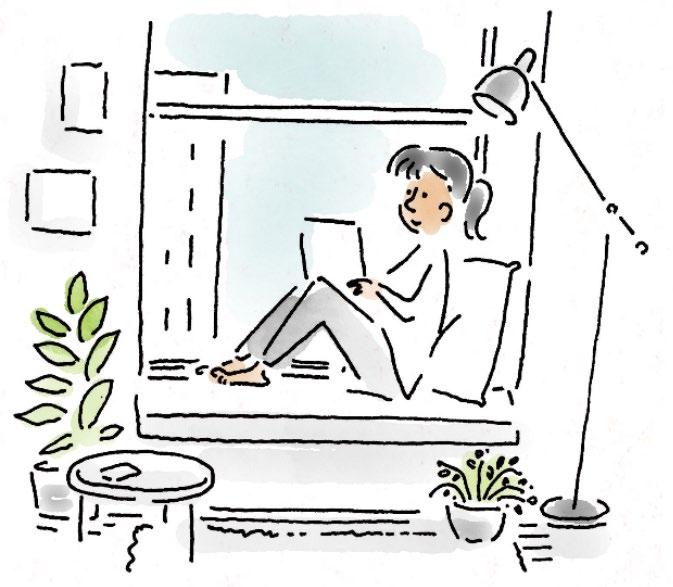
Creativity is highly coveted in today’s knowledgebased workplace, topping lists of skills desired by employers2—but what is it, exactly, and how can we help it along? Regarding its definition, most creativity researchers agree that creativity is “the generation of products or ideas that are both novel and appropriate.”3 Yet, a clear understanding of how, and under which conditions, creativity happens remains a point of debate.
When thinking of creativity, most people imagine coming up with many new ideas; but there are different types of creative thinking.4 Divergent thinking, or the ability to generate many different solutions to an open-ended problem, is one type

IMMERSION IN A CREATIVE PROBLEM OR MEDIUM
of creative thinking. There’s also another type of creativity called convergent thinking, or the ability to choose the best solution to a problem.5 These two processes tend to go hand-in-hand— once you generate many possible ideas, the challenge is then to sift through those ideas and select the most appropriate solution.
Likewise, creativity is often associated with “aha” or “eureka” moments of inspiration or insight. Indeed, insight is a central part of creativity. But creative work is theorized to occur iteratively through a process with several distinct phases: Preparation, incubation, illumination, and verification.6 When working through a creative problem, an individual

UNCONSCIOUS DEVELOPMENT OF A CREATIVE IDEA
must first gather materials and research the problem (preparation). The individual may then take a step away from the research and let ideas marinate in an unconscious process known as incubation. Illumination refers to the moment of insight where a creative solution seems to come unexpectedly. Verification is the process of evaluating and refining this creative solution.
Other cognitive processes associated with creativity include mind wandering and inspiration. Mind wandering, commonly defined as thought not focused on the task at hand,7 has been found to be associated with the generation of creative ideas (notably, when the content of mind wandering
is on something other than the creative idea), particularly moments of illumination.8 Inspiration describes a feeling of motivation to pursue a creative task,9 and is theorized by some to constitute a distinct stage of the creative process.10
Studying how creativity can be fostered has benefits not only for creative products, but for people. Although creativity has been associated with a “mad genius” stereotype that suggests that creativity comes at the cost of mental health, research shows that creativity in fact boosts psychological well-being and, furthermore, that this relationship goes both ways— greater well-being leads to increased creativity.11
Step 3.
ILLUMINATION

A SUDDEN MOMENT OF INSIGHT INTO A CREATIVE PROBLEM
Step 4.
VERIFICATION
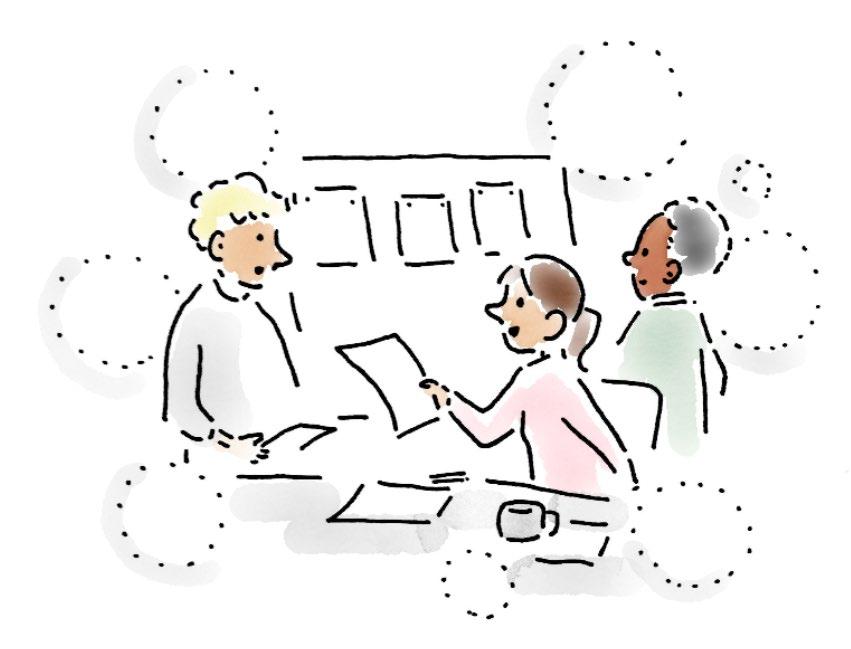
EVALUATION AND ADJUSTMENT OF THE CREATIVE IDEA
Much of the published research on creativity has focused on personality traits that are associated with creativity. What makes someone a creative person?
Personality researchers have theorized a “Big Five” inventory, breaking personality down into five basic facets: Extraversion, agreeableness, openness to experience, conscientiousness, and neuroticism.12 Creativity research has found that people who are more open to new experiences13 and more conscientious14 are also more likely to be creative.
Another personality trait associated with creativity is ambiguity tolerance, or the degree to which one is comfortable with open-ended situations and uncertainty. Researchers point to creativity as brought out in response to “unclear, vague and open-ended”5 situations. Given this overlap between creativity and ambiguity, it comes as no surprise that people who are more open to ambiguous situations are also more creative.16
If creativity is about personality, can it be fostered? While creativity is closely linked to personality, it’s also a state that can be fostered or suppressed based on context. For instance, research has found that creativity can be influenced by one’s social context,17 bodily cues (e.g., posture),18 the organizational context in a work setting,19 and by the phyiscal environment.20
There is growing work on the effects of the physical environment on creativity. For instance, research has shown that environments with dim lighting are associated with improved performance on creative tasks, compared to bright lighting;21 that lower complexity and more plants in an interior
workplace are associated with greater predicted creativity, as evaluated by office managers;22 and that rounded edges are associated with increased divergent thinking, whereas angular edges are associated with improved convergent thinking.23 However, recent work suggests that the particular effect a physical environment has on creativity may depend on the type of creative task performed, such as independent or collaborative work.24 No work to date has investigated how qualities of architectural interiors correspond to different phases of the creative process. Are there different spaces that are better for preparation compared to verification, for example, or divergent versus convergent thinking?
Exploration of how the built environment impacts creative thought and behavior is not only part of creativity research, but also part of research on environmental psychology, which investigates the effects of built and natural spaces on cognition, mood, and behavior.25 A recent environmental neuropsychological study found that basic psychological response to architectural interiors can be largely explained by how coherent, fascinating, and homey the room looks. The study also found that neural and psychological responses to building interiors have distinct patterns based on these visual architectural qualities, as well as the task one is engaged in.26 Incorporating the methodologies between these two fields— environmental neuropsychology and creativity—can help us understand how creativity is cognitively impacted by the environment and, more practically, to assist designers in applying empathy to the effects of built environments on creative thinking.

As part of the effort to better understand the effects of environmental design on creative thinking, we undertook an exploratory study of creativity in the built environment, with the aim of informing design strategies intended to promote creativity. Our study employed an experience sampling method, in which participants are surveyed several times a day to observe a particular process, joining a few existing studies on creativity using similar methods.27
The main purpose of this study was to better understand the relationship between the built environment and creative thinking. More specifically, our purpose was to examine which qualities of workplace interiors are positively associated with creativity in general as well as different components of creativity, including divergent thinking, convergent thinking, and phases of the creative process. In addition, we wished to investigate relationships between creativity and personality, creativity and posture, and creativity and mood to replicate previous findings. We chose to examine these variables in particular so that we could explore how relationships between creativity and one’s environment may change based on one’s personality, posture, and mood.
As this was an exploratory study, we did not have explicit hypotheses about our main variables of interest (i.e., creativity and environment variables). Based on previous findings, however, we predicted that we would find positive associations between creativity and trait openness and between creativity and conscientiousness,28
as well as a positive association between creativity and ambiguity tolerance.29
With regard to posture, we predicted based on past findings that we would find that more open (i.e., expansive) postures would be positively associated with greater creativity.30 We also explored whether leaning back or forward would be associated with creativity, for which we did not have an explicit hypothesis. Finally, we predicted that we would find a positive association between positive affect and creativity, based on past work.31
Creative professionals employed at One Workplace were recruited to participate in our experience sampling study. We restricted our population pool to creative professionals for this first round of data collection to give our study higher external validity, and as a first step before expanding our study to a general population. Our study was reviewed by Kansas State University’s Institutional Review Board (IRB) and was found to be exempt from full IRB review under the Federal Policy for the Protection of Human Subjects.
Participants were recruited with an email including a brief description of the study and a link to the mobile app. Recruitment emails were sent out to approximately 150 creative professionals at One Workplace. Thirty-five employees expressed interest in participating in the study; of these, 17 completed the study and sent us data files.


It seems that surroundings can influence creativity in different ways, in part depending on the stage of the process in which a person is involved.”
—Mihaly Csikszentmihalyi, Creativity32
The recruitment email acted as a consent letter, outlining what to expect during the study, as well as their rights as study participants (including the right to withdraw from the study). Participants who emailed the researchers to express interest in participating were sent instructions on how to download the app and complete the study.
The scheduled surveys were completed using the PIEL survey app (https://pielsurvey.org/), which works as a platform for experience sampling studies. Instruction emails were sent with a survey file attachment that participants opened using the PIEL app, which initiated the personality and demographic
survey. Completing this first survey initiated a schedule for ten daily surveys to be completed twice daily over five weekdays (Monday – Friday). Surveys were randomly scheduled to be completed once in the morning between 8:30 am – 12:00 pm and once in the afternoon between 1:00 pm – 5:00 pm. After completing the final scheduled survey, the app prompted participants to share their data. Participants were instructed to email their data files to the researchers. After receiving data, the researchers sent participants a feedback email with more information about the study and thanking them for their time. Participants who expressed interest in the study but did not send researchers data files were periodically emailed with a reminder to send their data files to the researchers after completing the study.
The personality and demographic survey included two personality questionnaires, as well as a brief demographic questionnaire to record participants’ industry, age, gender, and race/ethnicity. The personality questionnaires were designed to measure the “Big Five” personality factors and ambiguity tolerance. The Big Five questionnaire we employed was a brief, 10-item version of the longer Big Five Inventory developed by Rammstedt and John (2007). Ambiguity tolerance was measured with a 12-item scale developed by Herman et al. (2010).33 Participants were asked to indicate what industry they worked in as a validation of our sample restriction to those with creative professions.
Each of the ten daily surveys participants were asked to complete consisted of the same set of questions on the qualities of their environment, posture, mood, and what kind of creative thinking they were engaged in.
The questions about participants’ work environments were composed of scale items from Coburn et al. (2020), as well as questions developed ourselves. The Coburn et al. (2020) scale items were the nine items that formed three factors explaining 90% of the variance in psychological responses to building interiors: Coherence (four items), hominess (three items), and fascination (two items). The wording for one coherence item, approachability, was changed slightly to accommodate ratings for a room one is occupying (from “If I saw this room, I’d: Leave/ Enter” to “This room makes me feel: Like leaving/
Like staying”). In addition to these nine items, we included seven items about familiarity, brightness, natural light, views of nature, noise, flexibility, and the crowdedness of the space, to measure qualities of architectural interiors relevant to in-person use of workspaces. Participants also indicated whether they were at home, work, outside, or somewhere else.
Nine slider-scale questions asked participants about their creativity in that moment. These questions were designed to measure the four phases of the creative process (preparation, incubation, illumination, and verification), as well as felt inspiration, divergent thinking, general creativity, productivity, and collaboration. The question on felt inspiration was adapted from Thrash and Elliot’s (2003) Inspiration Scale;34 all other questions were developed for this study. In addition, participants were asked whether they were working at the time of the survey.
Participants’ postures were measured in two questions, both answered on slider scales. One question asked about to what extent participants were leaning back or leaning forward, and the other asked about the openness of their posture.
Mood was measured with one slider-scale question used in previous work35 to measure well-being in the moment.
The question order for each daily survey remained the same, except for randomization of the nine creativity questions on slider scales, plus the sixteen environment questions on slider scales. See Appendix for the full surveys.
W ho were our part icipant s?
Ages ranged from 26-66, with an average age of 50 years
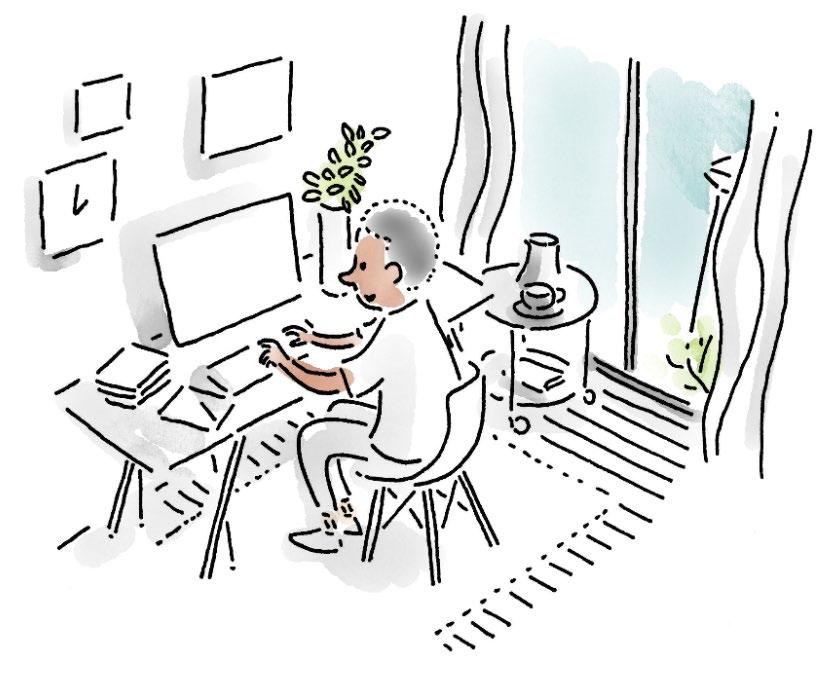
Prior to analysis, the data were prepared by the following processes: For the Big Five Inventory, several items were reverse scored (1, 3, 4, 5, and 7) and then values were calculated for each of the five traits by finding the mean of the following items: Extraversion: 1R, 6; Agreeableness: 2, 7R; Conscientiousness: 3R, 8; Neuroticism: 4R, 9; Openness: 5R, 10 (R = item is reversed-scored).
For the Ambiguity scale, several items were reversescored (1, 4, 5, 9, 10, 11, 12) and a total ambiguity score was calculated by finding the sum of all items.
For the environment questions, composites were created for the coherence, hominess, and fascination factors by calculating the mean of the following items: coherence (organization, beauty, valence, approachability), hominess
(naturalness, personalness, hominess), and fascination (complexity, interest).
Given the repeated measurements of the daily surveys, participants’ responses to the surveys were averaged (i.e., calculating the mean) by location (“home,” “work,” “outside,” and “somewhere else”) as well as averaged across all locations. If a participant did not take one of the daily surveys in one of the locations (e.g., “somewhere else”) then the participant did not have any averaged data for that particular location.
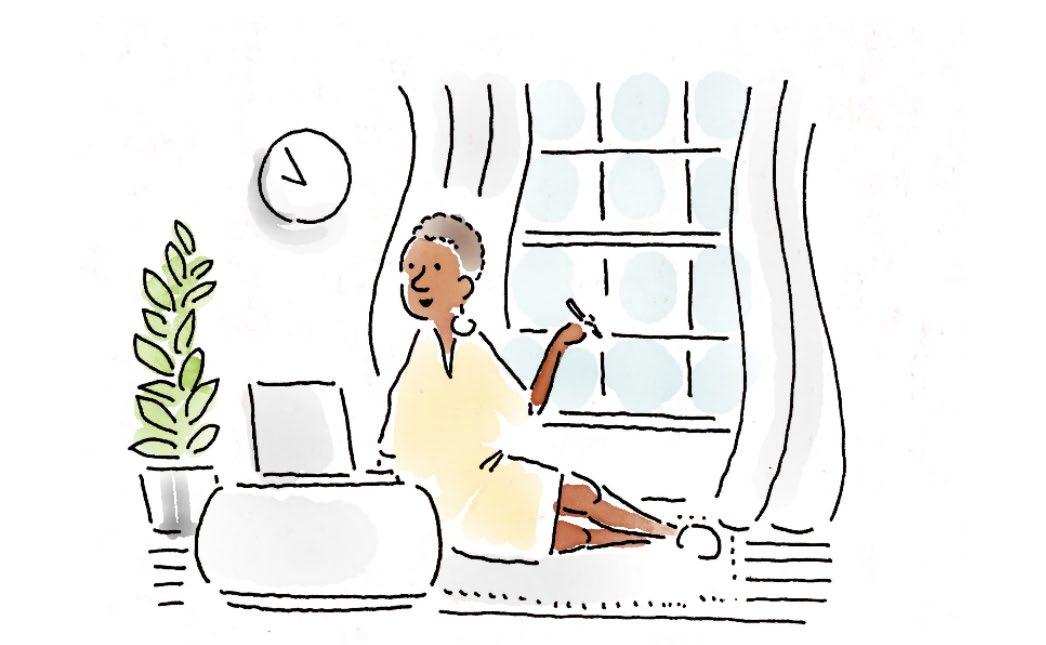
The data were analyzed using non-parametric statistics due to the small sample size (n=17) and the likely deviation from normality. The majority of respondents did not complete the daily survey in locations other than home, which prevented the use of Friedman tests (a non-parametric equivalent to a repeated measures ANOVA) to measure changes in creativity, environment, and mood based on location as it requires paired observations for each variable. Instead, participants’ overall average responses (averaged across all locations) were used in the analyses.
There were no significant relationships between any of the Big Five personality traits and the general creativity item that was averaged across locations.
A series of Spearman Rank-Order correlations were used to measure the degree of the monotonic relationship between the variables of interest. The Spearman Rank-Order correlation is a nonparametric equivalent to the Pearson correlation, and only requires data to be at least at the ordinal level and have paired observations. Unlike the Pearson correlation, Spearman correlation does not require data to be normally distributed and is acceptable for small sample sizes (n<20). All data were analyzed using SPSS Version 28 with an alpha level of 0.05 781534
Spearman Rank-Order Correlation Results between Big Five Traits and General Creativity
We had initially planned on examining whether creativity varies by location (home, work, outside, or somewhere else). However, we were unable to run this analysis because there were not enough surveys completed outside the home due to the Omicron variant of COVID-19, which meant most of our participants were working remotely. Regardless of location, the majority of daily surveys (82%) were completed when participants were working.
Are people who are more tolerant of ambiguity also more creative?
We did not find evidence to support this idea. There was no significant relationship between the total ambiguity scale and the general creativity item that was averaged across locations, r s(15) = .06, p = .808.
Is there a relationship between posture and creativity?
We found no significant relationship between posture and creativity. Posture angle (how far a person was leaning back or forward) was not significantly correlated with general creativity, r s(15) = .32, p = .216. Posture openness was also not significantly correlated with general creativity, r s(15) = .27, p = .293
Is there a relationship between mood and creativity?
We found no significant relationship between mood and general creativity, r s(15) = .33, p = .198.
Is there a relationship between environment and creativity?
We looked at whether there were any significant relationships between the environment variables (e.g., coherence, fascination, and hominess) and creativity variables (e.g., preparation, illumination, inspiration). (for the full list of all correlation coefficients, see Appendix). We found significant positive relationships between the hominess composite (averaged across the hominess, naturalness, and personal items) and three creativity variables (inspiration, illumination, and verification), indicating that homey environments were associated with more inspiration, greater moments of illumination, and greater evaluation or refinement of creative ideas. To dig into these relationships a bit deeper, we also ran correlation tests between the creativity variables and the individual scale items that comprised the hominess composite. We found that the more natural an environment looked, participants were significantly more likely to feel inspired, have moments of illumination, and engage in the verification phase of creativity. We also found that when evironments looked more personal, participants were significantly more likely to feel inspired.
Spearman Rank-Order Correlation Results between significant Environment and Creativity Items

“
We found that the more natural an environment was, participants were significantly more likely to feel inspired[...]”




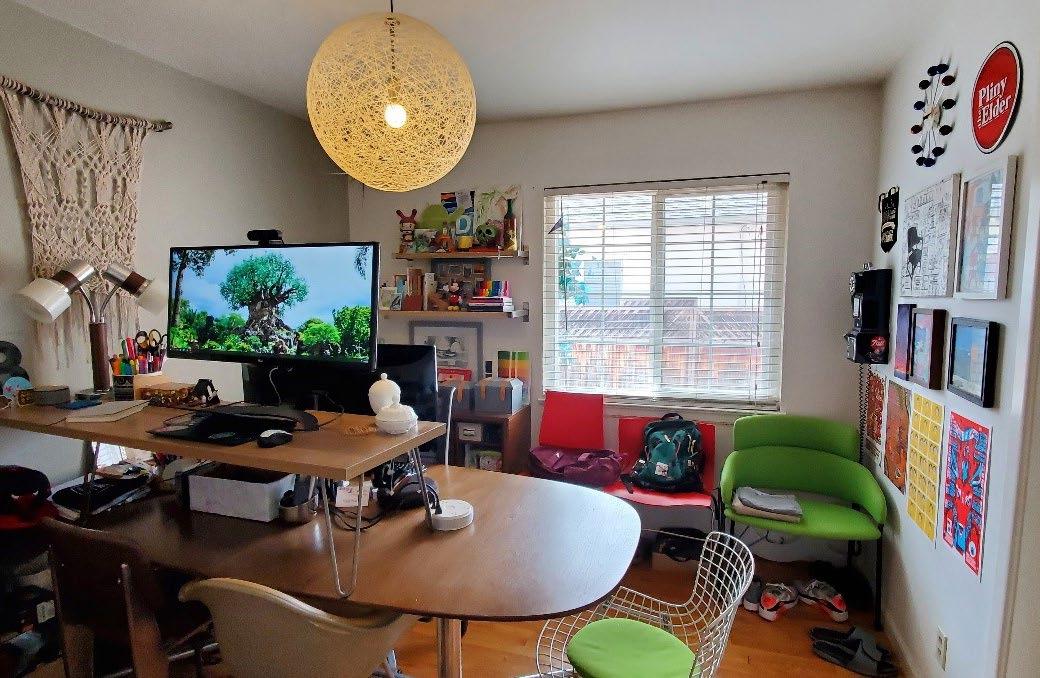
Samples of our participants’ workspaces during our study.


“
The objects around you should help you become what you intend to be.”
– Mihaly Csikszentmihalyi, Creativity36
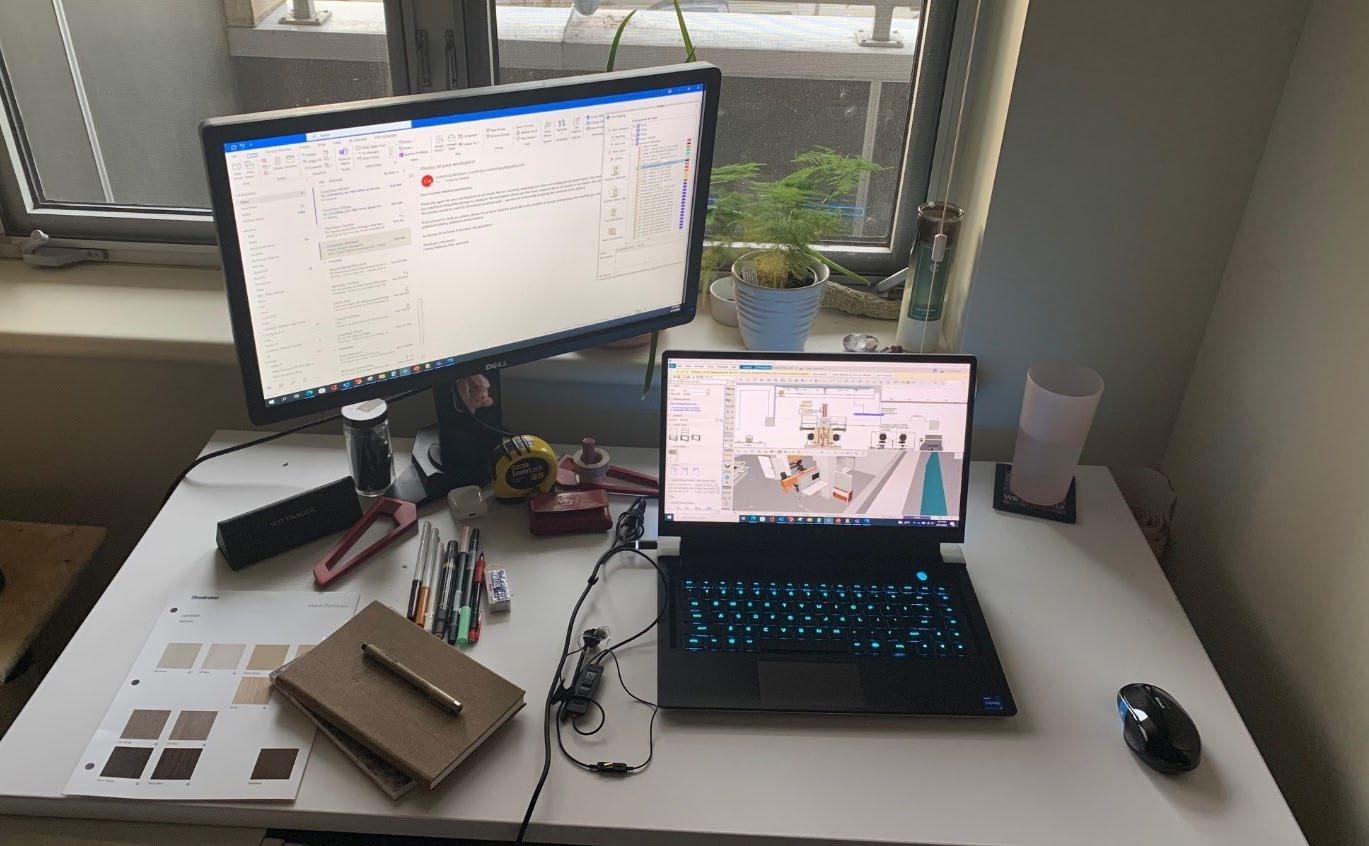
Our exploratory study found preliminary evidence of relationships between creativity and the built environment. Specifically, we found that homey environments—spaces that look natural, look personal, and make you feel at home—are correlated with feelings of inspiration, insight, and the process of evaluating or refining a creative problem. What might be underlying these relationships? One explanation comes from the “home advantage” phenomenon, which can be extended from sports stadiums to work environments. Much like sports teams who do well when playing on their own turf, research has found that people do their best work when they feel at home in an environment: As Annie Murphy Paul explains in her book The Extended Mind, “When people occupy spaces they consider their own, they experience themselves as more confident and capable.”37 This confirmation of one’s intuition is more significant than you might quickly imagine.
The “home advantage” benefits the creative process because being at home affords privacy, attentiveness, and space for concentration. For instance, when occupying a private space, we no longer have to devote mental resources toward maintaining an image for other people, which frees up mental space to concentrate
on creative pursuits.38 Moreover, working in privacy makes us more willing to try and risk failure by allowing “freedom to experiment unobserved.”39 (However, in the case of our study, we did not find a relationship between hominess and divergent thinking, i.e., coming up with new ideas.) The privacy afforded by being at home may also support task-independent thought, moments of elucidation, and a feeling of inspiration to chase a creative task, all of which are central to creative behavior.
Perhaps more relevant to our study results, a homey environment also allows for self-regulation by providing cues of identity and values, as suggested by Mihaly Csikszentmihalyi:
We need a supportive symbolic ecology in the home so that we can feel safe, drop our defenses, and go on with the tasks of life. And to the extent that the symbols of the home represent essential traits and values of the self, they help us be more unique, more creative.” 40 “

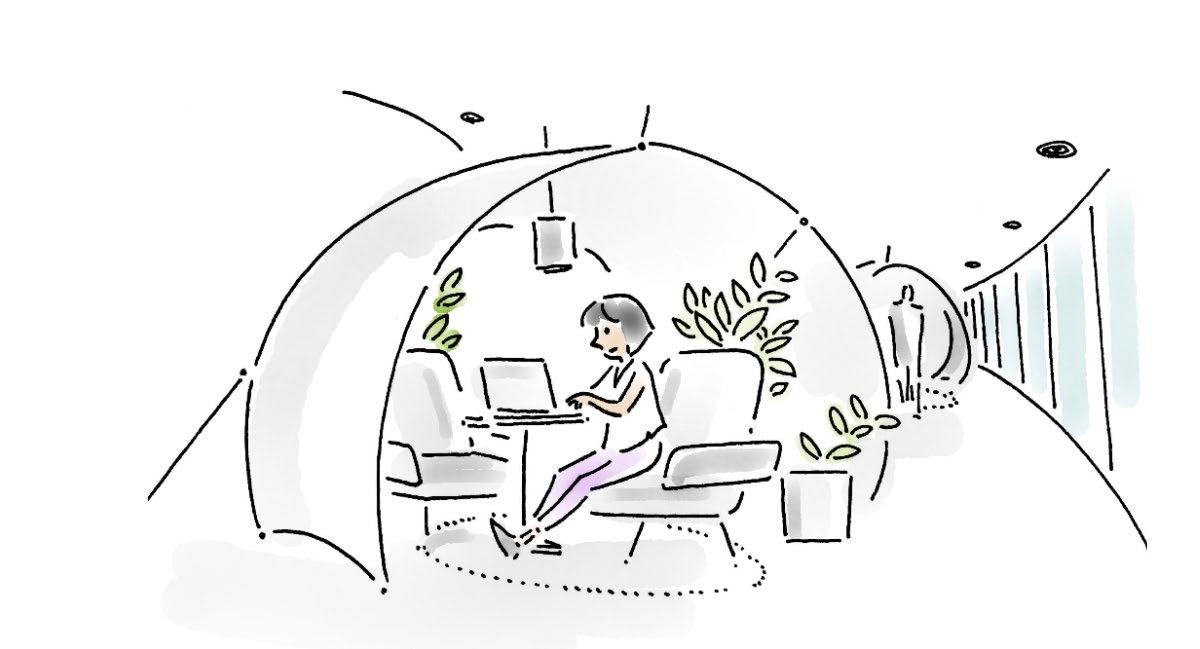
Our finding that hominess supports creativity was in part driven by the personalness of an environment, or how personal a space looks. Specifically, we found that personalness was significantly related to feelings of creative inspiration—the more personal a room looked, the more likely participants were to feel inspired. Seeing personal artifacts represented in our workspace may motivate us to pursue creative tasks by provoking memories, reminding us what we value, and generally reinforcing our sense of self.
More fundamentally, from an evolutionary standpoint, the feeling of being at home may be facilitated by occupying or creating a space that affords both prospect and refuge. According to prospect and refuge theory, people feel safest in environments that offer both a view of the surrounding area (prospect) and shelter and privacy (refuge).41 We speculate that feeling safe in this way may allow for moments of inspiration and illumination.
How might the connection between hominess and creativity translate to workplace design? Our findings seem to suggest that offices affording privacy and allowing for personalization promote creative thinking. Yet, in implementing hybrid work policies spurred by the COVID-19 pandemic, many companies are shifting away from private offices to open floorplans or even free-address seating—a desk-sharing arrangement that allows little privacy and is generally not conducive to personalization.42 Given the trend toward office-less design, it could be more important than ever to bring elements of comfort, personal identity, and privacy into the workplace.
Although we showed novel findings on creativity and the built environment, our study did not replicate previous findings on creativity and mood, creativity and personality, or creativity and ambiguity tolerance. These null findings may be due to our small sample
of seventeen participants. This size limitation also meant we could not run all of our planned analyses. Collecting more data from a larger, more diverse sample will allow for greater generalizability of our results and more powerful statistical analyses.
Another notable aspect of our study is that our data collection coincided with the recent Omicron wave of COVID-19. This meant that most participants were at home when completing the study surveys, which may have biased our results. In other words, did we find that hominess is associated with creativity because this relationship is unique and meaningful, or because participants happened to be mostly in homey environments while pursuing creative tasks? One result from our study suggesting that this relationship is meaningful and not biased by location is that familiarity was not significantly associated with any aspect of creativity. In other words, creativity did not signficantly change based on how familiar one’s environment was, but it did significantly change based on hominess. However, this result should also be taken cautiously because most environments in this study were rated as highly familiar.
Our pilot study lays the groundwork for important next steps, particularly to replicate our study with a larger sample with more diverse locations (e.g., home, office, outdoors). Our larger goal is to establish design strategies for facilitating creativity in different environments, including the workplace, and tailoring these strategies for different types of people.
Even though our data are preliminary, our findings support existing work on the “home advantage.” Combined with this past work, our preliminary results
reported here suggest that office environments should incorporate more natural, personal touches to make employees feel more at home. For instance, giving workers opportunities to make their space their own and incorporate personal elements may allow them to better engage in creative work. With more data, we will be able to determine whether hominess in an office setting has distinct effects on creativity than hominess at home. We also hope to compare creativity in different office settings, such as personalized office spaces versus free-address seating.
Our project is an important first step in mapping out the creative process in space, but there is much more to uncover. For instance, does the environment-creativity relationship change based on whether the creative work is individual or collaborative? How can the built environment support the distinct cognitive processes involved in preparation, incubation, illumination, and verification? We are excited to continue this work to unlock creativity in the office and beyond, and ultimately determine design strategies that support the creative process for different types of people.
1. Where are you?
• Home
• Work
• Outside
• Somewhere else
• Somewhere else? [Text entry]
2. What are you doing?
• I’m working
• I’m not working right now
Creativity questions (Slider scale; Not at all Extremely) (Randomized)
1. I’m thinking about a problem that needs a creative solution (Preparation)
2. I’m mind wandering (Incubation)
3. I had a moment of insight (Illumination)
4. I’m evaluating or refining a creative idea (Verification/Convergent thinking)
5. I feel inspired (Felt inspiration)
6. I’m coming up with new ideas (Divergent thinking)
7. I feel creative (General creativity)
8. I feel productive (Productivity)
9. I’m collaborating with other people right now (Collaboration)
Posture questions (Slider scale)
1. Describe your posture. Leaning back — Leaning forward
2. Describe your posture. Closed — Open
Environment questions (Slider scale; anchors next to each statement) (Randomized)
Coherence
1. This space looks… Disordered –Organized (Organization)
2. This space looks… Ugly – Beautiful (Beauty)
3. This space makes me feel… Bad – Good (Valence)
4. This space makes me feel… Like leaving – Like staying (Approachability)
Hominess
5. This space looks… Artificial –Natural (Naturalness)
6. This space looks… Impersonal –Personal (Personalness)
7. This space makes me feel… Alienated – At home (Hominess)
Fascination
8. This space looks… Simple – Complex (Complexity)
9. This space looks… Boring – Interesting (Interest)
10. This space is… New to me – Very familiar (Familiarity)
11. This space is… Dimly lit – Brightly lit (Brightness)
12. This space has… No natural light – Lots of natural light (Natural light)
13. This space has… No views of nature –Prominent views of nature (Views of nature)
14. This space is… Quiet – Loud (Noise)
15. This space looks… Rigid – Flexible (Flexibility)
16. This space is… Unpopulated –Populated (Crowdedness)
Mood question (slider scale)
How do you feel right now? Very bad – Very good
Big Five Inventory (Slider scale, Disagree strongly – Agree strongly)
1. I see myself as someone who is reserved [Reverse Coded]
2. I see myself as someone who is generally trusting
3. I see myself as someone who tends to be lazy [Reverse Coded]
4. I see myself as someone who is relaxed, handles stress well [Reverse Coded]
5. I see myself as someone who has few artistic interests [Reverse Coded]
6. I see myself as someone who is outgoing, sociable
7. I see myself as someone who tends to find fault with others [Reverse Coded]
8. I see myself as someone who does a thorough job
9. I see myself as someone who gets nervous easily
10. I see myself as someone who has an active imagination
Ambiguity tolerance scale (Slider scale, Disagree strongly – Agree strongly)
1. I avoid settings where people don’t share my values. [Reverse Coded]
2. I can enjoy being with people whose values are very different from mine.
3. I would like to live in a foreign country for a while.
4. I like to surround myself with things that are familiar to me. [Reverse Coded]
5. The sooner we all acquire similar values and ideals the better. [Reverse Coded]
6. I can be comfortable with nearly all kinds of people.
7. If given a choice, I will usually visit a foreign
country rather than vacation at home.
8. A good teacher is one who makes you wonder about your way of looking at things.
9. A good job is one where what is to be done and how it is to be done are always clear. [Reverse Coded]
10. A person who leads an even, regular life in which few surprises or unexpected happenings arise really has a lot to be grateful for. [Reverse Coded]
11. What we are used to is always preferable to what is unfamiliar. [Reverse Coded]
12. I like parties where I know most of the people more than ones where all or most of the people are complete strangers. [Reverse Coded]
1. What industry are you in?
• Architecture/Design
• Other [text response]
2. What is your age in years? [text response]
3. What gender do you most identify with?
• Man (including transman)
• Woman (including transwoman)
• Genderqueer / Gender non-conforming / Gender non-binary / Gender Fluid
• Something else [text response]
• I prefer not to answer
4. What is your racial background? Select all that apply.
• American Indian or Alaska Native
• Black/African
• East Asian (e.g., Chinese, Japanese, Korean)
• Southeast Asian (e.g., Filipino, Vietnamese, Indonesian)
• South Asian (e.g., Pakistani, Indian)
• Latino
• Middle Eastern
• Native Hawaiian or Other Pacific Islander
• West Indian/Caribbean
• White/Caucasian
• Other not listed above [text response]
• I prefer not to answer
Note: All slider scale questions are coded from 0-1
1 Howard Gardner, Creating Minds: An Anatomy of Creativity Seen Through the Lives of Freud, Einstein, Picasso, Stravinsky, Eliot, Graham, and Gandhi (New York: Basic Books, 1993), 35.
2 Bruce M. Anderson, “The Most In-Demand Hard and Soft Skills of 2020,” LinkedIn Talent Blog, LinkedIn, January 9, 2020, https://www. linkedin.com/business/talent/blog/talentstrategy/linkedin-most-in-demand-hard-andsoft-skills; Kate Whiting, “These Are the Top 10 Job Skills of Tomorrow—And How Long it Takes to Learn Them,” World Economic Forum, October 21, 2020, https://www.weforum. org/agenda/2020/10/top-10-work-skills-oftomorrow-how-long-it-takes-to-learn-them/.
3 Beth A. Hennessey and Teresa M. Amabile, “Creativity,” Annual Review of Psychology 61, no. 1 (2010): 569–98, https://doi.org/10.1146/ annurev.psych.093008.100416.
4 Hennessey and Amabile, “Creativity.”
5 Hennessey and Amabile, “Creativity.”
6 Graham Wallas, The Art of Thought (1931; reis., London: J. Cape, 1926), 79–107.
7 Jonathan Smallwood and Jonathan W. Schooler, “The Science of Mind Wandering: Empirically Navigating the Stream of Consciousness,” Annual Review of Psychology 66, no. 1 (2015): 487–518, https://doi.org/10.1146/annurevpsych-010814-015331.
8 Shelly L. Gable, Elizabeth A. Hopper, and Jonathan W. Schooler, “When the Muses Strike: Creative Ideas of Physicists and Writers Routinely Occur During Mind Wandering,” Psychological Science 30, no. 3 (2019): 396–404, https://doi. org/10.1177/0956797618820626.
10 Victoria C. Oleynick, Todd M. Thrash, Michael C. LeFew, Emil G. Moldovan, and Paul D. Kieffaber, “The Scientific Study of Inspiration in the Creative Process: Challenges and Opportunities,” Frontiers in Human Neuroscience 8 (2014): 436, https://doi. org/10.3389/fnhum.2014.00436.
11 Angela K.-Y. Leung, Brandon Koh, Riyang Phang, Sean TH Lee, and Tengjiao Huang, “Linking Creativity to Psychological Well-being: Integrative Insights from the Instrumental Emotion Regulation Theory,” The Journal of Creative Behavior (2021): 1–21, https://doi. org/10.1002/jocb.524; Cher-Yi Tan, ChunQian Chuah, Shwu-Ting Lee, and Chee-Seng Tan, “Being Creative Makes You Happier: The Positive Effect of Creativity on Subjective WellBeing,” International Journal of Environmental Research and Public Health 18, no. 14 (2021): 7244, https://doi.org/10.3390/ijerph18147244
12 Beatrice Rammstedt and Oliver P. John, “Measuring Personality in One Minute or Less: A 10-Item Short Version of the Big Five Inventory in English and German,” Journal of Research in Personality 41, no. 1 (2007): 203-212, https:// doi.org/10.1016/j.jrp.2006.02.001
13 Tamlin S. Conner and Paul J. Silvia, “Creative Days: A Daily Diary Study of Emotion, Personality, and Everyday Creativity,” Psychology of Aesthetics, Creativity, and the Arts 9, no. 4 (2015): 463, https://doi.apa.org/doi/10.1037/ aca0000022; Paul J. Silvia, Roger E. Beaty, Emily C. Nusbaum, Kari M. Eddington, Holly LevinAspenson, and Thomas R. Kwapil, “Everyday Creativity in Daily Life: An Experience-Sampling Study of “Little c” Creativity,” Psychology of
9 Todd M. Thrash and Andrew J. Elliot, “Inspiration as a Psychological Construct,” Journal of Personality and Social Psychology 84, no. 4 (2003): 871–89, https://doi.org/10.1037/00223514.84.4.871.
Aesthetics, Creativity, and the Arts 8, no. 2 (2014): 183, https://doi.apa.org/doi/10.1037/ a0035722.
14 Silvia et al., “Everyday Creativity in Daily Life.”
15 Scott Barry Kaufman, “The Neuroscience of Creativity: A Q&A with Anna Abraham,” Beautiful Minds (blog), Scientific American, January 4, 2019, https://blogs.scientificamerican.com/ beautiful-minds/the-neuroscience-of-creativity-aq-a-with-anna-abraham/.
16 Naiera Ebrahim Mahmoud, Shaimaa Mohamed Kamel, and Tamer Samir Hamza, “The Relationship between Tolerance of Ambiguity and Creativity in Architectural Design Studio,” Creativity Studies 13, no. 1 (March 23, 2020): 179–98, https://doi. org/10.3846/cs.2020.9628; Deborah W. Tegano, “Relationship of Tolerance of Ambiguity and Playfulness to Creativity,” Psychological Reports 66, no. 3 (June 1, 1990): 1047–56, https://doi.org/10.2466/pr0.1990.66.3.1047; Franck Zenasni, Maud Besançon, and Todd Lubart, “Creativity and Tolerance of Ambiguity: An Empirical Study,” The Journal of Creative Behavior 42, no. 1 (2008): 61–73, https://doi. org/10.1002/j.2162-6057.2008.tb01080.x.
17 Miriam Erez and Rikki Nouri, “Creativity: The Influence of Cultural, Social, and Work Contexts,” Management and Organization Review 6, no. 3 (2010): 351–70, https://doi. org/10.1111/j.1740-8784.2010.00191.x.
18 Nicolas Michinov and Estelle Michinov, “Do Open or Closed Postures Boost Creative Performance? The Effects of Postural Feedback on Divergent and Convergent Thinking,” Psychology of Aesthetics, Creativity, and the Arts, (2020), https://psycnet.apa.org/doi/10.1037/ aca0000306.
19 Teresa M. Amabile, Regina Conti, Heather Coon, Jeffrey Lazenby, and Michael Herron, “Assessing the Work Environment for Creativity,” Academy of Management Journal 39, no. 5 (1996): 1154–84, https://doi.org/10.2307/256995
20 Canan Ceylan, Jan Dul, and Serpil Aytac, “Can the Office Environment Stimulate a Manager’s Creativity?” Human Factors and Ergonomics in Manufacturing 18, no. 6 (2008): 589–602, https://doi.org/10.1002/hfm.20128; Tatsuya Daikoku, Qi Fang, Tomohito Hamada, Youichi Handa, and Yukie Nagai, “Importance of Environmental Settings for the Temporal Dynamics of Creativity,” Thinking Skills and Creativity 41 (2021): 100911, https://doi. org/10.1016/j.tsc.2021.100911; Anna Steidle and Lioba Werth, “Freedom from Constraints: Darkness and Dim Illumination Promote Creativity,” Journal of Environmental Psychology 35, (2013): 67–80, https://doi. org/10.1016/j.jenvp.2013.05.003; Yueyan Wu, Chongyu Lu, Jianhui Yan, Xiao Chu, Meijiao Wu, and Zhi Yang, “Rounded or Angular? How the Physical Work Environment in Makerspaces Influences Makers’ Creativity,” Journal of Environmental Psychology 73 (2021): 101546, https://doi.org/10.1016/j.jenvp.2020.101546.
21 Steidle and Werth, “Freedom from Constraints.”
22 Ceylan, Dul, and Aytac, “Can the Office Environment Stimulate a Manager’s Creativity?”
23 Wu et al., “Rounded or Angular?”
24 Daikoku et al., “Importance of Environmental Settings for the Temporal Dynamics of Creativity;” Donatella De Paoli, Erika Sauer, and Arja Ropo, “The Spatial Context of Organizations: A Critique of ‘Creative Workspaces,’” Journal of Management & Organization 25, no. 2 (2019): 331–52, https://doi.org/10.1017/jmo.2017.46;
Katja Thoring, Pieter Desmet, and Petra BadkeSchaub, “Creative Environments for Design Education and Practice: A Typology of Creative Spaces,” Design Studies 56, (2018): 54–83, https://doi.org/10.1016/j.destud.2018.02.001
25 Colin Ellard, Places of the Heart: The Psychogeography of Everyday Life (New York: Bellevue Literary Press, 2015); Gary W. Evans and Janetta Mitchell McCoy, “When Buildings Don’t Work: The Role of Architecture in Human Health,” Journal of Environmental Psychology 18, no. 1 (1998): 85–94, https://doi.org/10.1006/ jevp.1998.0089; Robert Gifford, “Environmental Psychology Matters,” Annual Review of Psychology 65 (2014), 541–579, https://doi. org/10.1146/annurev-psych-010213-115048; Sarah Williams Goldhagen, Welcome to Your World: How the Built Environment Shapes Our Lives (New York: Harper, 2017); Hanna R. Negami, Robin Mazumder, Mitchell Reardon, and Colin G. Ellard, “Field Analysis of Psychological Effects of Urban Design: A Case Study in Vancouver,” Cities & Health 2, no. 2 (2019): 106–115, https://doi.org/10.1080/237488 34.2018.1548257; Oshin Vartanian, Gorka Navarrete, Anjan Chatterjee, Lars Brorson Fich, Jose Luis Gonzalez-Mora, Helmut Leder, Cristián Modroño, Marcos Nadal, Nicolai Rostrup, and Martin Skov, “Architectural Design and the Brain: Effects of Ceiling Height and Perceived Enclosure on Beauty Judgments and ApproachAvoidance Decisions,” Journal of Environmental Psychology 41 (2015): 10–18, https://doi. org/10.1016/j.jenvp.2014.11.006.
26 Alexander Coburn, Oshin Vartanian, Yoed N. Kenett, Marcos Nadal, Franziska Hartung, Gregor Hayn-Leichsenring, Gorka Navarrete, José L. González-Mora, and Anjan Chatterjee, “Psychological and Neural Responses to Architectural Interiors,” Cortex 126 (2020):
217–241, https://doi.org/10.1016/j. cortex.2020.01.009
27 Silvia et al., “Everyday Creativity in Daily Life;” Mathias Benedek, Emanuel Jauk, Kevin Kerschenbauer, Ruth Anderwald, and Leonhard Grond, “Creating Art: An Experience Sampling Study in the Domain of Moving Image Art,” Psychology of Aesthetics, Creativity, and the Arts 11, no. 3 (2017): 325, https://psycnet. apa.org/doi/10.1037/aca0000102; Maciej Karwowski, Izabela Lebuda, Grzegorz Szumski, and Anna Firkowska-Mankiewicz, “From Momentto-Moment to Day-to-Day: Experience Sampling and Diary Investigations in Adults’ Everyday Creativity.” Psychology of Aesthetics, Creativity, and the Arts 11, no. 3 (2017): 309, https:// psycnet.apa.org/doi/10.1037/aca0000127
28 Conner and Silvia, “Creative Days;” Silvia et al., “Everyday Creativity in Daily Life.”
29 Mahmoud, Kamel, and Hamza, “The Relationship between Tolerance of Ambiguity and Creativity in Architectural Design Studio;” Tegano, “Relationship of Tolerance of Ambiguity and Playfulness to Creativity;” Zenasni, Besançon, and Lubart, “Creativity and Tolerance of Ambiguity.”
30 Michinov and Michinov, “Do Open or Closed Postures Boost Creative Performance?”
31 Leung et al., “Linking Creativity to Psychological Well-being;” Tan et al., “Being Creative Makes You Happier.”
32 Mihaly Csikszentmihalyi, Creativity: Flow and the Psychology of Discovery and Invention (New York: HarperCollins Publishers, 1997), 146.
33 Jeffrey L. Herman, Michael J. Stevens, Allan Bird, Mark Mendenhall, and Gary Oddou, “The Tolerance for Ambiguity Scale: Towards a More
Refined Measure for International Management Research,” International Journal of Intercultural Relations 34, no. 1 (2010): 58–65, https://doi. org/10.1016/j.ijintrel.2009.09.004
34 Thrash and Elliot, “Inspiration as a Psychological Construct.”
35 Matthew A. Killingsworth, “Experienced WellBeing Rises with Income, Even Above $75,000 per Year,” Proceedings of the National Academy of Sciences 118, no. 4 (2021), https://www.pnas. org/doi/10.1073/pnas.2016976118
36
38 Shira Baror and Moshe Bar, “Associative Activation and Its Relation to Exploration and Exploitation in the Brain,” Psychological Science 27, no. 6 (2016): 776–89, https://doi. org/10.1177/0956797616634487; Kathleen D. Vohs, Roy F. Baumeister, and Natalie J. Ciarocco, “Self-Regulation and Self-Presentation: Regulatory Resource Depletion Impairs Impression Management and Effortful Self-Presentation Depletes Regulatory Resources,” Journal of Personality and Social Psychology 88, no. 4 (2005): 632, http://dx.doi.org/10.1037/00223514.88.4.632.
39 Paul, The Extended Mind, 125.
40 Csikszentmihalyi, Creativity, 142.
41 Jay Appleton, The Experience of Landscape (New York: Wiley, 1975).
42 “2020 Global Occupier Sentiment Survey: The Future of the Office,” CRBE Research, 2020, cbre. com/-/media/files/future%20of%20work/futureof-the-office-v2.pdf.
Perkins Eastman and Kansas State University would like to thank our study participants for their time and effort to help us investigate the relationship between the built environment and creative thinking. We are very grateful to One Workplace for all of their support and giving us the opportunity to conduct this research with the ONEder grant.


Authors: Perkins Eastman: Hanna Negami, Katherine Gluckselig, and Rebecca Milne
Kansas State University: Bob Condia
Support: Jess Charlap, Jingxian Xu, Lindsay Fischer, and Zac Redden
Photography: Copyright Andrew Rugge/ Courtesy Perkins Eastman: Front and back cover, table of contents, page 6
We thank our anonymous study participants for providing photos on pages 15 - 16
Illustrations Copyright: Ling Zhong: page 2, 3, 4, 8, 10, 11, 14, 17, 18, 20
Graphic Copyright: Perkins Eastman: page 10, 12, 13
Statistical support from Lance Kruse at Invontics Study funded and supported by One Workplace
